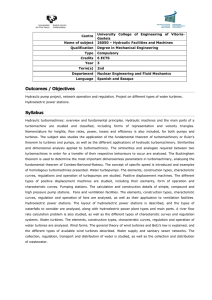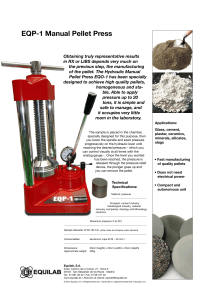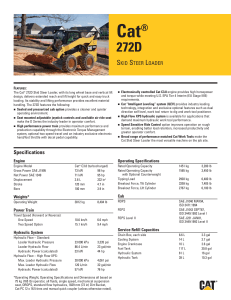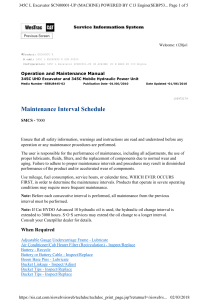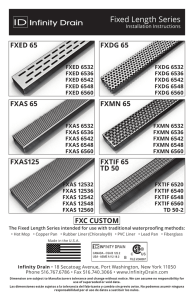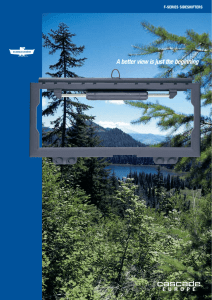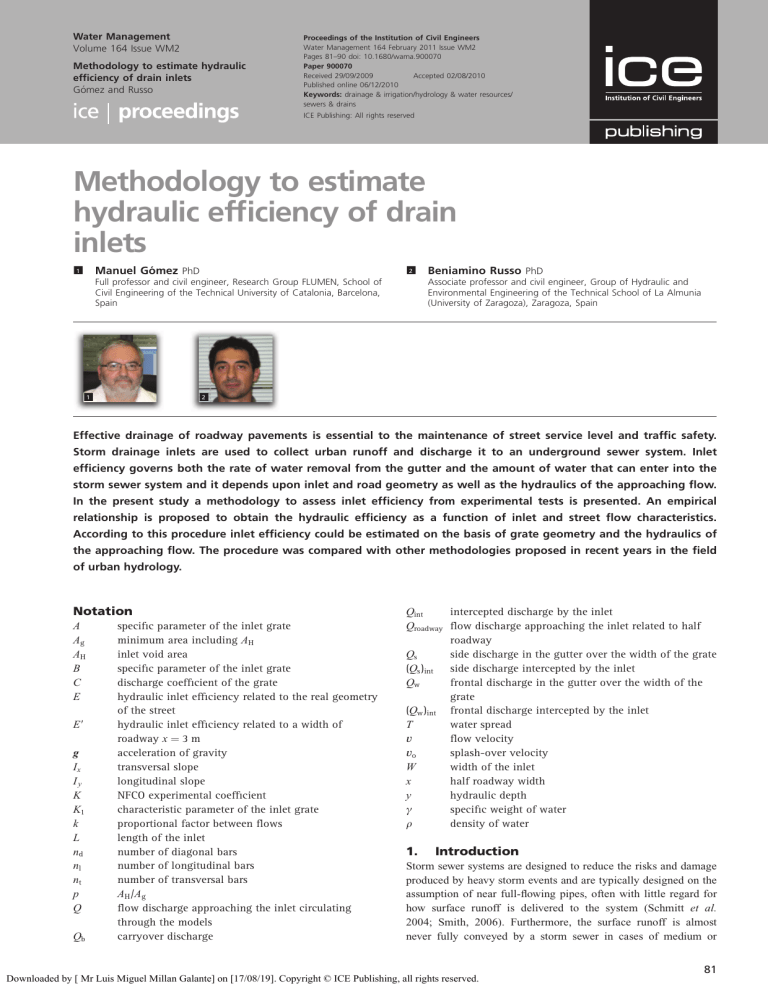
Water Management Volume 164 Issue WM2 Methodology to estimate hydraulic efficiency of drain inlets Gómez and Russo Proceedings of the Institution of Civil Engineers Water Management 164 February 2011 Issue WM2 Pages 81–90 doi: 10.1680/wama.900070 Paper 900070 Received 29/09/2009 Accepted 02/08/2010 Published online 06/12/2010 Keywords: drainage & irrigation/hydrology & water resources/ sewers & drains ICE Publishing: All rights reserved Methodology to estimate hydraulic efficiency of drain inlets 1 j Manuel Gómez PhD 2 j Beniamino Russo PhD Full professor and civil engineer, Research Group FLUMEN, School of Civil Engineering of the Technical University of Catalonia, Barcelona, Spain 1 j Associate professor and civil engineer, Group of Hydraulic and Environmental Engineering of the Technical School of La Almunia (University of Zaragoza), Zaragoza, Spain 2 j Effective drainage of roadway pavements is essential to the maintenance of street service level and traffic safety. Storm drainage inlets are used to collect urban runoff and discharge it to an underground sewer system. Inlet efficiency governs both the rate of water removal from the gutter and the amount of water that can enter into the storm sewer system and it depends upon inlet and road geometry as well as the hydraulics of the approaching flow. In the present study a methodology to assess inlet efficiency from experimental tests is presented. An empirical relationship is proposed to obtain the hydraulic efficiency as a function of inlet and street flow characteristics. According to this procedure inlet efficiency could be estimated on the basis of grate geometry and the hydraulics of the approaching flow. The procedure was compared with other methodologies proposed in recent years in the field of urban hydrology. Notation A Ag AH B C E E9 g Ix Iy K K1 k L nd nl nt p Q Qb specific parameter of the inlet grate minimum area including AH inlet void area specific parameter of the inlet grate discharge coefficient of the grate hydraulic inlet efficiency related to the real geometry of the street hydraulic inlet efficiency related to a width of roadway x ¼ 3 m acceleration of gravity transversal slope longitudinal slope NFCO experimental coefficient characteristic parameter of the inlet grate proportional factor between flows length of the inlet number of diagonal bars number of longitudinal bars number of transversal bars AH /Ag flow discharge approaching the inlet circulating through the models carryover discharge Qint intercepted discharge by the inlet Qroadway flow discharge approaching the inlet related to half roadway Qs side discharge in the gutter over the width of the grate (Qs )int side discharge intercepted by the inlet Qw frontal discharge in the gutter over the width of the grate (Qw )int frontal discharge intercepted by the inlet T water spread v flow velocity vo splash-over velocity W width of the inlet x half roadway width y hydraulic depth ª specific weight of water r density of water 1. Introduction Storm sewer systems are designed to reduce the risks and damage produced by heavy storm events and are typically designed on the assumption of near full-flowing pipes, often with little regard for how surface runoff is delivered to the system (Schmitt et al. 2004; Smith, 2006). Furthermore, the surface runoff is almost never fully conveyed by a storm sewer in cases of medium or Downloaded by [ Mr Luis Miguel Millan Galante] on [17/08/19]. Copyright © ICE Publishing, all rights reserved. 81 Water Management Volume 164 Issue WM2 Methodology to estimate hydraulic efficiency of drain inlets Gómez and Russo heavy rainfall owing to the lack of an efficient system of drainage inlets. An inadequate surface drainage may be due to poor inlet locations or to an inefficient individual inlet capacity. 2: Q b ¼ Qroadway Q int where Qb is the bypass discharge (m3 /s). Inlet efficiency governs, at the same time, both the rate of water removal from the gutter and the amount of water that can enter the storm drainage system. In this frame, it is obvious that the general problem of the urban drainage cannot consider these two distinct components separately: (1) the surface (or ‘major’) system composed of streets, ditches, and various natural and artificial channels and (2) a subsurface storm sewer network or ‘minor’ system (Smith, 2006). Prior to the 1980s, Kidd and Helliwell (1977) described the urban runoff process as a twophase phenomenon, incorporating a surface phase with an underground phase. They recognized the complexity of the interactions between these two phases by stating: ‘Unfortunately, there is no clear-cut interface between the two phases’. Surface collecting systems represent this interface and nowadays the lack of knowledge about the hydraulic behaviour of these types of structures (inlets, macro-inlets, continuous grates, etc.) has not been fully overcome. Poor knowledge of the hydraulic behaviour of surface drainage structures could produce unreliable simulations from storm water management models (Russo et al., 2005) and suggest a considerable amount of surface runoff that can interrupt traffic, reduce skid resistance and increase the potential of hydroplaning (Guo, 1997). Generally a proper surface drainage of roadway pavements is an essential condition to maintain a good street service level and a good traffic safety level. Pavement drainage requires consideration of the hydrological condition and rainfall pattern, hydraulics of the gutter flow, hydraulic inlet capacity and risk criteria related to urban runoff in the case of storm. All these factors affect the design of an inlet drainage system. 2. Inlet efficiency: state of the art The hydraulic capacity of a storm drainage inlet is a function of grate type, gutter flow, geometric road conditions and clogging phenomena related to the void area of the grate. The efficiency of an inlet is defined as the ratio of the discharge intercepted by the inlet to the total discharge approaching the inlet 1: E¼ In the field of analytical procedures, flow over a grate represents a typical example of spatially varied flow with decreasing discharge. Several authors, using trough semi-theoretical studies, have proposed equations for the spatially varied flow profile relating the intercepted flow to the specific energy or the flow depth and a discharge coefficient C depending on the grate geometry (Mostkow, 1957; Noseda, 1956; Subramanya and Sengupta, 1981). These studies were carried out making the assumptions of rectangular (transversal slope Ix ¼ 0%) and prismatic channels considering only frontal one-dimensional flow (without side flow). Moreover a relevant problem concerning inlet efficiency is that the available published data on the hydraulic capacity of inlets are specific to the particular typologies that were tested and have not been generalized. As a consequence, the use of the methodologies carried out and the results obtained are only applicable to a limited number of inlet types. For instance, these are the cases of the Hydraulic Engineering Circular No. 22 (following HEC22) procedure (ASCE, 1992) or Neenah Foundry Company (following NFCO) procedure (NFCO, 1998). The HEC-22 procedure considers that the analysis of the interception capacity of a grate inlet requires the determination of a frontal flow (Qw ) which is the discharge in the gutter over the grate width, and the side flow (Qs ) which is the discharge along the side of the grate. Once Qw and Qs are known, the frontal flow intercepted by the inlet (Qw )int and the side flow intercepted (Qs )int can be determined from graphs and relationships obtained experimentally. Specifically, efficiency E is related to a parameter named splash-over velocity (vo ) (the minimum velocity at which some of the frontal flow passes over the grate without being intercepted). As with other parameters involved in this procedure, vo , depends on the grate type and the grate length in the flow direction and can be determined only for the grates tested during the experimental campaign. Using the HEC-22 nomenclature, hydraulic efficiency E (defined as a decimal between 0 and 1) becomes Q int Qroadway 3: where E is the hydraulic inlet efficiency (defined as a decimal between 0 and 1), Qint is the discharge intercepted by the inlet (m3 /s), and Qroadway is the total discharge approaching the inlet related to half roadway (m3 /s). The flow that is not intercepted by an inlet, carryover (ASCE 1992; Guo, 1997) or bypass flow (Nicklow and Hellman, 2004) is defined as follows: 82 E¼ (Qw )int þ (Qs )int Qroadway In the context of the inlet manufacturers, a North American foundry tested its grates to calculate their hydraulic capacity. The results were plotted logarithmically for given longitudinal and transverse slopes. Based on these results, the following relationship between the flow intercepted by the inlet Qint (expressed in cubic feet per second) and the water depth (expressed in feet) at the kerb immediately upstream from the inlet (y) was proposed Downloaded by [ Mr Luis Miguel Millan Galante] on [17/08/19]. Copyright © ICE Publishing, all rights reserved. Water Management Volume 164 Issue WM2 4: Methodology to estimate hydraulic efficiency of drain inlets Gómez and Russo Qint ¼ K y 5=3 The specific parameter K varies depending on longitudinal (I y ) and transversal street slopes (Ix ). Evidently the methodology can be used only for the tested grates (NFCO, 1998). A few generalised design methods for predicting the flow capacity of inlets have been identified (Argue, 1986; Li, 1956; Spaliviero and May, 1998). The first method was developed by Li at John Hopkins University (Li, 1956). This method requires the knowledge of three non-dimensional coefficients, and only very limited testing has been carried out to determine their values for the types of grates used in Europe. It appears to be fairly generally accepted that hydraulic testing of gratings can be carried out satisfactorily using scale models (Spaliviero and May, 1998). This implies that correct application of Froude similarity should enable results from this phase of the study to be generalized to inlets of different sizes. In order to evaluate its suitability, Li’s method was analysed in a study of the Hydraulic Research Wallingford Limited (following HR Wallingford) (Spaliviero and May, 1998) in the UK because it was the normal procedure indicated by the British Standard Code of Practice (BS 6367) (BSI, 1983) to design the drainage systems for roofs, roads and other paved areas. In particular it was demonstrated that nondimensional parameters used in Li’s procedure are not constant but depend on the flow condition upstream from the inlet. The study concerned typical grates used in the UK (these grates present a poor hydraulic efficiency and dimensions smaller than the common grates used in the rest of Europe and in the USA) and, according to the experimental protocol, maximum circulating flows were rather limited (Q/y ratio reached the maximum value of 1.5) (Martı́nez, 2000). The results proposed in this paper improve the procedure demonstrating the ineffectiveness of Equation 5 for a large spectrum of circulating flow (Q/y ratio up to 15–20) and for the typical grates used in other countries. 3. Experimental campaign 3.1 Test facilities The most common inlets used in Barcelona were tested in the hydraulic laboratory of the Technical University of Catalonia (following UPC) by a platform that can simulate the hydraulic behaviour of a roadway (Figure 1). Tests were made in a 1 : 1 scale model of a roadway measuring 3 m wide and 5.5 m long. The platform is able to simulate lanes with a transversal slope up to 4% and longitudinal slope up to 14%. According to the system capacity, it is possible to test drain inlets and study their hydraulic capacity for a large set of flows (0–0.2 m3 /s) (Gómez et al., 2002). The second method (Spaliviero and May, 1998) constitutes the basis of the methodology that will be explained in this paper. In 1996 the Highways Agency of the UK commissioned HR Wallingford, in association with the Transport Research Laboratory, to carry out a study on the hydraulic performance of inlets used to collect surface runoff from roads. The study consisted of experimental tests on several inlet grates used in the UK and the objective was to develop a consolidated design method to define inlet spacing depending on the road geometry and the grate type. Tests were carried out using a 1 : 1 hydraulic model. Through the analysis of the results, it was demonstrated that inlet efficiency E and the ratio Q/y can be related, where Q is the discharge circulating through Spaliviero and May’s model and y is the flow depth upstream from the inlet measured at the kerb. In this case all the efficiency values from different flow widths and crossslopes have been collapsed into a single curve which can be approximated as a straight line. In this way, the analysis of the experimental data showed that, except at low efficiency values, the results for an individual inlet could be described satisfactorily by a linear equation E against Q/y (Spaliviero and May, 1998) 5: E ¼ 102:7 K 1 (a) Q y (b) where E is the inlet efficiency (expressed in %) and K1 is a characteristic parameter related to the grate geometry. Figure 1. UPC platform and testing area Downloaded by [ Mr Luis Miguel Millan Galante] on [17/08/19]. Copyright © ICE Publishing, all rights reserved. 83 Water Management Volume 164 Issue WM2 Methodology to estimate hydraulic efficiency of drain inlets Gómez and Russo Pumps supply the flow up to a tank placed approximately 15 m above the platform. A motorised slide valve regulates the flow discharged to the model. Discharge measurement is done by an electromagnetic flow meter with an accuracy of 1 l/s. The flow circulates through the model, first through a tank located upstream of the platform. This tank dissipates the flow energy and provides a horizontal profile to the surface water level. In this way the surface water elevation is the same for the entire platform width and the model reproduces the runoff through a roadway in a more realistic way. In this frame the flow may more easily reach the steady and normal depth conditions. The discharge intercepted by the inlet is conveyed to a V-notch triangular weir and the flow measurement is carried out through a limnimeter with an accuracy of 0.1 mm. Flow depth measurements on the platform are obtained directly with a thin graduated invar scale. The first results of the experimental campaign showed that inlet efficiency decreased for high longitudinal slopes and circulating flows and increased for high transversal slopes. For the maximum circulating flow of testing (0.2 m3 /s) and high longitudinal slopes (from 4 to 10%) the inlets tested presented a hydraulic efficiency between 10 and 20% depending on the transversal slopes (Figure 4). Experimental data were used to create summary tables about hydraulic efficiency for each type of grate inlet depending on the geometric conditions of the street. For cases not included in the testing protocol, interpolation and extrapolation were required. For all these reasons a new and more general expression was developed. 3.2 Testing protocol and UPC methodology As a first step in the experimental campaign, 11 different inlets (Table 1) were tested to determine their hydraulic capacity for a large range of geometric conditions and approaching discharges. The results for the first nine inlets (Figure 2) were used to develop a methodology to determine inlet efficiency, while the data concerning the latest two inlets were used to validate the procedure (Figure 3). The testing protocol established the following geometric conditions for different circulating flows: (a) Q (total discharge approaching to the inlet through the model): 0.02, 0.05, 0.1, 0.15 and 0.2 m3 /s 4. Hydraulic approach From the dimensional analysis it can be established that the discharge flow captured by any particular grate depends basically on the grate size and shape, water depth and velocity of the flow upstream of the inlet, and the specific weight and density of the water. This relationship can be expressed as Qint ¼ f ð L, y, v, ª, rÞ in which Qint is the discharge intercepted by the inlet, L is a characteristic length of the problem, y and v are the water depth and velocity in the gutter and street upstream of the inlet, and ª and r are the specific weight and density of water. Dimensional analysis leads to the relationship 6: Qc y v pffiffiffiffiffiffiffiffiffi ¼ f , pffiffiffiffiffiffiffi T gT gT 5 (b) Ix (transversal slope): 0, 1, 2, 3 and 4% (c) I y (longitudinal slope): 0, 0.5, 1, 2, 4, 6, 8 and 10%. As can be expected, one of the dimensionless numbers is the Froude number, because the flow along the street is basically Grate Length (L): cm Width (W): cm Area including void area (Ag ): m2 Void area (AH ): m2 Number of longitudinal bars (nl ) Number of transversal bars (nt ) Number of diagonal bars (nd ) Type Type Type Type Type Type Type Type Type Type Type 78 78 64 77.6 97.5 80 60.2 74.5 100 60.2 99.9 36.4 34.1 30 34.5 47.5 30 31.5 26 50 31.5 50 0.2114 0.1850 0.1647 0.2250 0.3431 0.1622 0.1807 0.1540 0.5000 0.1807 0.4940 0.1214 0.0873 0.0693 0.1050 0.1400 0.0736 0.0881 0.0852 0.2012 0.0865 0.1760 5 1 1 2 3 0 2 1 1 2 1 1 17 0 13 7 15 1 0 3 0 3 0 0 12 0 0 0 10 11 21 8 28 1 2 3 4 5 6 7 8 9 10 11 Table 1. Geometric characteristics of the tested grates 84 Downloaded by [ Mr Luis Miguel Millan Galante] on [17/08/19]. Copyright © ICE Publishing, all rights reserved. Water Management Volume 164 Issue WM2 Methodology to estimate hydraulic efficiency of drain inlets Gómez and Russo 1 4 7 Figure 2. Some of the grates tested during the experimental campaign (grate types 1, 2, 3, 4, 5, 6, 7, 8, 9) 2 3 8 6 9 5 Figure 3. The two grates used to validate the methodology carried out (grate types 10 and 11) governed by gravity forces. The other two numbers are related one to the cross-section (y/T, invert aspect ratio if y is water depth and T is water spread), and the other to the approaching flow. So the first term can be expressed with another dimensionless number, E ¼ Qint /Q, inlet/grate efficiency. Any data obtained from laboratory testing could be expressed in terms of these dimensionless numbers. Different tests were carried out with the dimensionless numbers proposed, but finally the same ratio Q/y was used, presented in Spaliviero and May (1998), the parameter that showed the best results for the whole data set for every inlet. On the basis of the analysed data, it was shown that the function efficiency plotted against Q/y is not exactly linear as supposed by Spaliviero and May. In fact for a large spectrum of flow conditions (up to Downloaded by [ Mr Luis Miguel Millan Galante] on [17/08/19]. Copyright © ICE Publishing, all rights reserved. 85 Water Management Volume 164 Issue WM2 Methodology to estimate hydraulic efficiency of drain inlets Gómez and Russo 1·0 E Grate Type 8 Q ⫽ 0·2 m3/s 0·8 Ix ⫽ 4% 0·6 Ix ⫽ 2% 0·4 Ix ⫽ 0% 0·2 0·0 0 0·5 1 4 2 6 Longitudinal slope: % 8 10 Figure 4. Test results related to the grate 3 and different geometric conditions for an approaching flow of 0.2 m3 /s and different transversal slopes (Ix ) 1·0 0·9 0·8 0·7 0·6 E 0·5 0·4 0·3 0·2 0·1 0·0 Experimental values Experimental trendline E ⫽ 0·3551(Q/y)⫺0·85 R2 ⫽ 0·9323 4 2 0 6 8 Q/y: m2/s 10 14 12 Figure 5. Experimental data and proposed power trendline 0.2 m3 /s) and consequently, with a range of hydraulic efficiencies as low as 10%, a power law expression was proposed 7: E9 ¼ A the grate (such as void area, number and type of the bars, etc.) through two parameters A and B B Q y : A¼ 8: where E9 is the hydraulic efficiency of the inlet for a 3 m wide lane (defined as a decimal between 0 and 1), Q is the discharge approaching the inlet circulating through the model (m3 /s), y is the flow depth measured at the curb immediately upstream from the inlet (m), A is the empirical coefficient of the inlet grate, and B is the empirical coefficient of the inlet grate. High correlation coefficients (from 81% up to 93%) between experimental data and potential trendlines were obtained for all the inlet grates (Table 2; Figure 5). As the background and the state of the art in this field demonstrate, one of the most important problems related to inlet efficiency assessment is that the procedures developed can be used only for the grates tested during previous experimental campaigns. In order to estimate inlet efficiency without inlet-specific laboratory data, based on the experience of Spaliviero and May (1998), the second phase of this study consisted of relating the characteristic parameters A and B and the geometry of the inlet grates. The important goal obtained was that these coefficients, which should properly be determined by experimental tests, could be estimated from some geometric characteristics too. Experimental results linked inlet efficiency to some geometric parameters of Grate type Correlation coefficient: % 1:988 A0g 403 : : L0179 B ¼ 1:346 0394 W 9: where Ag is the area of the smallest rectangle having sides parallel to the kerb containing all the void of the grate (including bars area) (m2 ), p is the ratio between the void area (AH ) and Ag (in %), nt is the number of transversal bars, nl is the number of longitudinal bars, nd is the number of diagonal bars, L is the length of the inlet (cm) and W is the width of the inlet (cm). In comparison with the Spaliviero and May (1998) expression, coefficients A and K1 present a relevant similarity, while the new coefficient B considers the main dimensions of the grate. In the previous studies, grates with small dimensions (only one reached a length of 50 cm) were tested. This type of grate is typical of countries with low rainfall intensity. On the contrary a large spectrum of grate dimensions was used in this study (width: from 33 to 63 cm; length: from 47.5 to 100 cm). Experimental results related to other inlets (types 10 and 11) were 1 2 3 4 5 6 7 8 9 10 11 81.04 91.20 92.13 85.08 88.39 88.05 90.34 93.23 82.53 88.73 81.97 Table 2. Correlation coefficient between experimental data and potential law achieved 86 : p0:190 (nt þ 1)0 088 (nl þ 1)0 012 (nd þ 1)0 082 Downloaded by [ Mr Luis Miguel Millan Galante] on [17/08/19]. Copyright © ICE Publishing, all rights reserved. Water Management Volume 164 Issue WM2 Methodology to estimate hydraulic efficiency of drain inlets Gómez and Russo Grate type 10 1·0 0·9 0·8 0·7 0·6 E 0·5 0·4 0·3 0·2 0·1 0·0 Sidewalk Platform lane of 3 m width Experimental values Q Experimental trendline y Ix Calculated trendline E ⫽ 0·3522(Q/y)⫺0·718 R2 ⫽ 0·8873 0 5 10 15 Q/y: m2/s 20 Qroadway Figure 7. Roadway cross-section for the condition x . 3 (m) and 3Ix < y < xIx 25 Figure 6. Validation phase of the procedure by two other grates (grate type 10) platform). A specific case is shown in Figure 7, and the values of coefficient k for each street geometric condition and each flow depth y are shown in Table 3. Once E9 was calculated, the intercepted flow (Qint ) could be determined by the equation 11: used to validate the procedure carried out (Figure 6). The great similarity between the potential curves plotted from experimental data and the curve plotted by the calculation of parameters A and B on the basis of grates geometry can be seen in Figure 6. So, through Equations 7, 8 and 9, it is possible to approach the hydraulic efficiency of any inlet in a similar way to the tested ones, in cases where there have been no experimental tests. The procedure for inlet efficiency estimation was carried out from experimental tests on a 3 m wide platform, so it should be used for a roadway with two lanes of 3 m width (one lane for each traffic direction). In order to extend the methodology to any roadway width with uniform gutter, assuming the hypothesis of uniform velocity distribution in the hydraulic cross-section, other equations were determined. For streets with several lanes presenting a half roadway width x that is different to 3 m, it is possible to generalise Equation 7 according to the flow depth (y) 10: x: width of half roadway Qroadway B E9 ¼ A k y where y is the flow depth immediately upstream from the inlet (m), Qroadway is the flow approaching an inlet related to half roadway (m3 /s), E9 is the inlet efficiency related to a width of half roadway x ¼ 3 m (defined as a decimal between 0 and 1) and k is the coefficient related to the street geometric conditions and to the flow depth (y). Qroadway is the circulating flow associated with the real geometry of the street, whereas Q was the circulating flow through the model. Flow hydraulic section, and consequently the flow depths, may vary depending on the street geometry. Qroadway and Q generate the same flow depth at the kerb y. The product k Qroadway represents the discharge Q approaching the inlet for a roadway width x ¼ 3 m (or the discharge circulating through the UPC Qint ¼ E9 Q ¼ E9 k Qroadway The most common hydrological softwares (such as HEC-HMS) or storm sewer model (SWMM5.0, Mike Urban, Infoworks CS, Half roadway width x ¼ 3 m Any y k¼1 Half roadway width x , 3 m y < xIx k¼1 xIx < y < 3Ix k¼ 1 1 1 y > 3Ix x Ix y 2 3 Ix 2 1 1 y k¼ x Ix 2 1 1 y Half roadway width x . 3 m y < 3Ix k¼1 3 Ix 2 3Ix < y < xIx k ¼1 1 y y > xIx 3 Ix 2 1 1 y k¼ x Ix 2 1 1 y Note: k is the coefficient related to the street geometric conditions and to the flow depth y; Ix is the transversal slope of the gutter (m/m); k is the correlation coefficient (m/m); x is the half roadway width (m); y is the flow depth upstream of the inlet (m). Table 3. Coefficient k for each type of street geometric conditions and each flow depth Downloaded by [ Mr Luis Miguel Millan Galante] on [17/08/19]. Copyright © ICE Publishing, all rights reserved. 87 Water Management Volume 164 Issue WM2 Methodology to estimate hydraulic efficiency of drain inlets Gómez and Russo etc.) allow the characterisation of diversion elements (inlets, weirs, etc.) through inflow/outflow tables. From Equations 10 and 11 it is possible to obtain a very useful expression that relates the approaching discharge to the inlet and the intercepted one and to compare these results with the experimental values obtained during the tests. In Table 4 the result for the longitudinal slope I y ¼ 1% and transversal slope Ix ¼ 0% are shown. In this table it is possible to observe that discharge coefficients C and intercepted flow values Qint are generally lower than experimental data. These differences are due to the intercepted flow coming from side flow and seem to justify the need for empirical approaches for the study of inlet efficiency in order to take into account the two-dimensional behaviour of the flow. Moreover, it was demonstrated that, in the case of gutter flow, the coefficient of discharge was strongly influenced by the non-zero transversal slope (Martı́nez, 2000). 12: Qroadway B Qint ¼ k Qroadway A k y Owing to the laboratory conditions described in the previous section, the kinematic wave model and normal depth conditions could be assumed as a first approach for the inlets system design. It is clear that for the particular geometric conditions of the street (for example low longitudinal slopes) this approach may cause significant deviations. So assuming normal depth upstream of the inlet (in m), Qroadway (in m3 /s) can be estimated by Izzard’s equation 13: Qroadway ¼ Cf 8=3 1=2 y Iy n Ix where Cf is the constant (¼ 0.376 m1=3 /s for SI units), n is the Manning’s roughness coefficient, Ix is the gutter transversal slope (m/m), and I y is the gutter longitudinal slope (m/m). Equation 13 is a modified form of the Manning equation. Izzard modified Manning’s equation because the hydraulic radius does not adequately describe the gutter cross-section, particularly where the water spread may be more than 40 times the curb depth (Izzard, 1946). 5. Comparative analysis of the UPC method and other procedures First several analyses were carried out to calculate the discharge coefficients C and intercepted flow Qint by the Subramanya and Sengupta (1981) and Noseda (1956) approach for the grate type 2 Concerning the comparison with experimental methodologies, the UPC procedure was compared to the HEC-22 (US Department of Transportation, 1996) and NFCO (1998) methods. Some drain inlets were analysed through these different methodologies and the similarity of the results in terms of efficiency was demonstrated (Gómez and Russo, 2005). In particular Figure 8 shows the captured flows, calculated by the UPC and HEC-22 methodologies, plotted against the circulating flows for a specific grate analysed in the HEC-22 circular (P50*100). In this graph, which is related to a specific geometric configuration, it is possible to observe that the captured flow values are very similar for the circulating flow range 0– 0.12 m3 /s. For higher flows, HEC-22 proposes a higher efficiency than the UPC method. The same behaviour was observed for other geometric conditions. The maximum circulating flow considered in the HEC-22 was 0.14 m3 /s, for higher values extrapolation is required, while during the UPC experimental campaign the value of the maximum flow reached was 0.2 m3 /s. So the HEC-22 procedure seemed to overestimate hydraulic efficiency for high circulating flows. The UPC procedure was also compared with the NFCO (1998) method. In this case the grate R-3246-E-F type C was analysed and chosen for its similarity to the grates tested during the UPC 0·12 Comparative graph Q–Qint Analytical data Experimental data Q: m3 /s y: m C Qint : m3 /s C Qint 0.050 0.100 0.150 0.215 0.014 0.024 0.032 0.040 0.08 0.09 0.09 0.09 0.005 0.008 0.009 0.010 0.05 0.10 0.14 0.16 0.004 0.008 0.014 0.018 Table 4. Comparative analysis between numerical and experimental approaches in terms of discharge coefficients and intercepted flows for the grate type 2 and a longitudinal slope I y ¼ 1% 88 Qint: m3/s 0·10 0·08 UPC HEC-22 0·06 0·04 0·02 0·00 0·00 0·01 0·02 0·03 0·05 0·08 0·12 0·17 0·23 0·30 Q: m3/s Figure 8. Intercepted flow plotted against circulating flow for the grate P-50*100 of the HEC-22 procedure and a specific grate geometry (transversal slope ¼ 2%, longitudinal slope ¼ 2%). Downloaded by [ Mr Luis Miguel Millan Galante] on [17/08/19]. Copyright © ICE Publishing, all rights reserved. Water Management Volume 164 Issue WM2 Methodology to estimate hydraulic efficiency of drain inlets Gómez and Russo Comparative graph (Iy ⫽ 1%) 30 20 K 10 NFCO UPC 0 0 1 2 3 Ix: % 4 5 6 Figure 9. Comparative graph about ‘K’ data between UPC and NFCO methodologies for the grate R-3246-E-F Type C and the longitudinal slope Iy ¼ 1% experimental campaign. As in the other comparative study, the hydraulic capture efficiency of this grate was analysed for different geometric conditions according to the two methodologies. The results showed a great convergence of the data, above all for low longitudinal slopes (Figure 9). In this case the comparative study concerned circulating flows up to 0.12 m3 /s. 6. Conclusions Considering a 1 : 1 scale hydraulic structure, a series of experimental studies on inlet grates were carried out considering higher discharges than the values used in previous experimental studies. A new methodology for inlet efficiency estimation has been developed and it can be used for a large spectrum of inlet dimensions. A potential equation to relate hydraulic inlet capacity to street flow conditions and two inlet-specific parameters is proposed. The specific parameters can be obtained from test data or can be approached from the inlet geometry, so the procedure can be applied to any non-tested inlet similar to those presented. The procedure has been generalised for each geometric condition of streets with uniform triangular gutter section including a coefficient k, as a function of the road geometry. Comparative studies were carried out among some methodologies. The results confirm the usefulness of the UPC procedures and a great convergence in terms of results. Moreover, the proposed methodology could be applied to characterise, through inflow/outflow tables, the hydraulic surface drainage structures in the codes normally used for the approach of sewer system and dual drainage modelling. REFERENCES Argue JR (1986) Storm Drainage Design in Small Urban Catchments, a Handbook for Australian Practice. Australian Road Research Board, South Vermont, Victoria, Australia, Special Report No. 34. ASCE (American Society of Civil Engineering) (1992) Design and Construction of Urban Stormwater Management System. ASCE Manuals and Reports on Engineering Practice No. 77, ASCE, New York, USA. BSI (British Standards Institution) (1983) BS 6367: Drainage of Roofs and Paved Area. BSI, London, UK. Gómez M and Russo B (2005) Comparative study of methodologies to determine inlet efficiency from test data. HEC-12 methodology vs UPC method. Proceedings of the Conference Water Resources Management III, Wessex Institute of Technology. WIT Press Southampton, Boston, UK, pp. 633–642. Gómez M, Sánchez H, Malgrat P, et al. (2002) Inlet spacing considering the risk associated to runoff: application to streets and critical points of the City of Barcelona. Global Solutions for Urban Drainage, 9th International Conference on Urban Drainage, (9ICUD) (Strecker EW and Huber WC (eds)). ASCE/IWA/EWRI/IAHR, Reston, VA. Guo JCY (1997) Street Hydraulics and Inlet Sizing. Using the Computer Model UDINLET. Water Resources Publications, LCC, Colorado, USA. Izzard CF (1946) Hydraulics of runoff from developed surfaces. Proceedings of the Highway Research Board, vol. 26, pp. 129–150, Highway Research Board, Washington DC, USA. Kidd CHR and Helliwell PR (1977) Simulation of the inlet hydrograph for urban catchments. Journal of Hydrology, 35(1–2): 159–172. Li WH (1956) The Design of Stormwater Inlets. John Hopkins University, Baltimore, MD, USA, internal report. Martı́nez P (2000) Estudio de eficiencia de la captación de rejas y criterios de ubicación en viales urbanos. Thesis for the Civil Engineer Degree, Technical University of Catalonia, Barcelona, Spain. Mostkow MA (1957) A theoretical study of bottom type water intakes. La Houille Blanche 12(4): 570–580. NFCO (Neenah Foundry Company) (1998) Inlet grate capacity. In Construction castings, Catalog – R, 12th edn. Engineering Laboratory Design, Inc., Neenah, Wisconsin, USA. Nicklow JW and Hellman PA (2004) Optimal design of storm water inlets for highway drainage. Journal of Hydroinformatics 06(4): 245–257. Noseda G (1956) Correnti permanenti con portata progressivamente decrescente, defluenti su griglie di fondo. L’Energia Elettrica 33(6): 565–584. Russo B, Gómez M, Martı́nez P and Sánchez H (2005) Methodology to study the surface runoff in urban streets and the design inlets systems. Application in a real case study. Proceedings of the 10th International Conference on Urban Drainage, Copenhagen, Denmark. Schmitt TG, Thomas M and Ettrich N (2004) Analysis and modeling of flooding in urban drainage systems. Journal of Hydrology 299(3–4): 300–311. Smith MB (2006) Comment on ‘Analysis and modeling of Downloaded by [ Mr Luis Miguel Millan Galante] on [17/08/19]. Copyright © ICE Publishing, all rights reserved. 89 Water Management Volume 164 Issue WM2 Methodology to estimate hydraulic efficiency of drain inlets Gómez and Russo flooding in urban drainage systems’. Journal of Hydrology, 317(1–2): 355–363. Spaliviero F and May RWP (1998) Spacing of Road Gullies. Hydraulic Performance of BS EN 124 Gully Gratings. HR Wallingford, UK, internal report. Subramanya K and Sengupta D (1981) Flow through bottom racks. Indian Journal of Technology 19(2): 64–67. US Department of Transportation (1996) Urban Drainage Design Manual. US Department of Transportation, Washington DC, USA, Hydraulic Engineering Circular No. 22. WHAT DO YOU THINK? To discuss this paper, please email up to 500 words to the editor at [email protected]. Your contribution will be forwarded to the author(s) for a reply and, if considered appropriate by the editorial panel, will be published as a discussion in a future issue of the journal. Proceedings journals rely entirely on contributions sent in by civil engineering professionals, academics and students. Papers should be 2000–5000 words long (briefing papers should be 1000–2000 words long), with adequate illustrations and references. You can submit your paper online via www.icevirtuallibrary.com/content/journals, where you will also find detailed author guidelines. 90 Downloaded by [ Mr Luis Miguel Millan Galante] on [17/08/19]. Copyright © ICE Publishing, all rights reserved.

